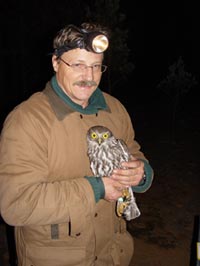
Study ensures protection for timber industry and Barking Owls

Dr Kavanagh used radio transmitters to
help determine the habitat of the Pilliga
Barking Owls.
New knowledge about the rare Barking Owl is helping to protect its habitat in the Pilliga scrub, in the central north of NSW, whilst also providing foresters with greater access to timber.
Noted for its rare wook-wook sound, the Barking Owl in recent decades has become far less abundant in the areas where it traditionally lives – the drier forests and woodlands near rivers and billabongs in coastal areas and inland slopes and plains dominated by agriculture.
Following the discovery of a substantial population of Barking Owls in the Pilliga State Forests, NSW Department of Primary Industries’ Principal Research Scientist, Dr Rod Kavanagh, undertook a study into the owls’ habitat requirements in that area.
A specialist in forest biodiversity, Dr Kavanagh examined the importance for the owl of forest ‘edges’ and forest types suitable for nesting, roosting and foraging.
Results were presented in December last year to Forests NSW and the NSW Department of Environment and Conservation as part of negotiations to develop harvesting prescriptions for the Pilliga.
Dr Kavanagh said the parties thoroughly reviewed all aspects of the study and common agreement was reached about the biological significance of the data.
'This data will now be used to develop a new set of forest management prescriptions for this species in the Southern Brigalow region.
'The prescriptions will form part of the new forestry licence provisions and, consequently, are expected to reduce the level of uncertainty faced by various sawmillers about future wood supplies in the region.'
Dr Kavanagh said the net result of the discussions will be protection of the owl’s habitat and a significant increase in the available wood supply, compared to the amount available under the precautionary prescriptions that have operated over the past 2-4 years.
'There has also been a significant reduction in the amount of field-time required to be spent in pre-harvest surveys for this species', he said.
The Barking Owl, Ninox connivens, was listed as a vulnerable species under the NSW Threatened Species Conservation Act in 1998.
Further information
Dr Rod Kavanagh, NSW DPI, Pennant Hills on 02 9872 0111 or rodk@sf.nsw.gov.au.
Email:

